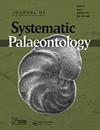中侏罗纪Woodeaton采石场(牛津郡)的新异基因标本及其对haramiyidan多样性和系统发育的影响
IF 2.2
2区 地球科学
Q3 EVOLUTIONARY BIOLOGY
引用次数: 0
摘要
我们报道了来自英国Woodeaton采石场(牛津郡)侏罗纪中期白石灰岩地层的新的异基因牙齿标本。oxfordensis的Kermackodon(=Eleutherodon)有两颗牙齿,这是一个分类单元,其原始属名(Eleutheroton)被占据,在这里被分配给Kermackoton,以形成一个新的物种名称的二项式组合。Butlerodon quadratus gen.et sp.nov.(Kermackodontidae科)以13颗颊齿和门牙为基础,显示出介于牛津K.oxfordensis和晚三叠纪“haramiyidans”(Haramiyavia和Thomasia)之间的牙齿特征。Woodeatonia parva gen.et sp.nov.(不确定家族)以三颗牙齿为基础,其特征是体积小。多结核杆菌的第二个上臼齿被鉴定为Hahnotherium(参见H.antiquum),它具有多结核杆菌特有的特征,但与“haramiyidans”不同。来自森林大理石组的异基因牙齿,以前被分配给哈拉米伊丹“Eleutherodon”、“Millsodon”和“Kirtlingtonia”,以及多结核Kermackodon,被重新解释为来自同一哈拉米伊丹科物种K.oxfordensis的不同上部或下部牙齿位点的牙齿,这导致了这些同种异体(“haramiyidans”和多结核菌)的显著分类修饰。考虑到Kermackodon被认为是多结核菌和“haramiyidans”之间的过渡形式,这些分类单元的修改将影响对异基因早期进化的解释。在对已知“haramiyidans”臼齿的比较中,我们深入研究了它们的咬合模式和尖端同源性,这些模式和同源性一直存在争议,但对理解异基因进化至关重要。我们进一步对原米伊丹种进行了首次系统发育分析。欧洲晚三叠世物种组成了“haramiyidans”的茎向分类群,英国侏罗纪物种与中国延辽生物群的乔木类haramiyids组合,并嵌套在“haramiyi dans”中。http://zoobank.org/urn:lsid:zoobank.org:pub:38F1FB5A-17A2-498F-B1FD-38D975548201http://zoobank.org/urn:lsid:zoobank.org:act:FF5ADA10-C044-4541-ADA6-54448F17C673http://zoobank.org/urn:lsid:zoobank.org:act:6E59071A-56DF-43D2-A140-2860465BFECAhttp://zoobank.org/urn:lsid:zoobank.org:act:CA2EE3CF-951C-450A-879D-2AE438F6BB2Ahttp://zoobank.org/urn:lsid:zoobank.org:act:6B26D9C3-9FC3-4517-A1EF-51822067F970本文章由计算机程序翻译,如有差异,请以英文原文为准。
New allotherian specimens from the Middle Jurassic Woodeaton Quarry (Oxfordshire) and implications for haramiyidan diversity and phylogeny
We report new allotherian tooth specimens from the Middle Jurassic White Limestone Formation at Woodeaton Quarry (Oxfordshire), United Kingdom. Two teeth are assigned to Kermackodon (=Eleutherodon) oxfordensis, a taxon whose original generic name (Eleutherodon) was preoccupied and is here assigned to Kermackodon to form a new binomial combination for the species name. Butlerodon quadratus gen. et sp. nov. (family Kermackodontidae), based on 13 cheek teeth and incisors, shows dental features intermediate between K. oxfordensis and the Late Triassic “haramiyidans” (Haramiyavia and Thomasia). Woodeatonia parva gen. et sp. nov. (family indeterminate), based on three teeth, is characterized by its small size. A second upper molar from a multituberculate is identified as Hahnotherium cf. H. antiquum, which possesses characters typical for multituberculates but distinctive from “haramiyidans”. The allotherian teeth from the Forest Marble Formation, previously assigned to the haramiyidans “Eleutherodon”, “Millsodon” and “Kirtlingtonia”, and the multituberculate Kermackodon, are reinterpreted as teeth from different upper or lower dental loci of the same haramiyidan species K. oxfordensis, which result in significant taxonomical modification of these allotherians (“haramiyidans” and multituberculates). Given that Kermackodon has been regarded as a transitional form between multituberculates and “haramiyidans”, these taxonomical modifications would affect interpretation of early evolution of allotherians. In a comparison of molars in known “haramiyidans”, we delve into their occlusal patterns and cusp homologies that have been controversial but pivotal for understanding evolution of allotherians. We further conduct the first phylogenetic analysis of haramiyidan species. The European Late Triassic species form the stem-ward taxa of “haramiyidans” and the Jurassic species from the United Kingdom are grouped with arboroharamiyids from the Yanliao Biota, China, and nested in “haramiyidans”. http://zoobank.org/urn:lsid:zoobank.org:pub:38F1FB5A-17A2-498F-B1FD-38D975548201 http://zoobank.org/urn:lsid:zoobank.org:act:FF5ADA10-C044-4541-ADA6-54448F17C673 http://zoobank.org/urn:lsid:zoobank.org:act:6E59071A-56DF-43D2-A140-2860465BFECA http://zoobank.org/urn:lsid:zoobank.org:act:CA2EE3CF-951C-450A-879D-2AE438F6BB2A http://zoobank.org/urn:lsid:zoobank.org:act:6B26D9C3-9FC3-4517-A1EF-51822067F970
求助全文
通过发布文献求助,成功后即可免费获取论文全文。
去求助
来源期刊
CiteScore
5.30
自引率
7.70%
发文量
31
审稿时长
>12 weeks
期刊介绍:
The Journal of Systematic Palaeontology publishes papers that provide novel and impactful results in phylogenetics and systematics and that use these results in ways that significantly advance rigorous analyses of palaeogeography, palaeobiology, functional morphology, palaeoecology or biostratigraphy. Papers dealing with theoretical issues or molecular phylogenetics are also considered if they are of relevance to palaeo-systematists. Contributions that include substantial anatomical descriptions, descriptions of new taxa or taxonomic revisions are welcome, but must also include a substantial systematics component, such as a new phylogeny or a revised higher-level classification. Papers dealing primarily with alpha-taxonomic descriptions, the presentation of new faunal/floristic records or minor revisions to species- or genus-level classifications do not fall within the remit of the journal.

 求助内容:
求助内容: 应助结果提醒方式:
应助结果提醒方式:


